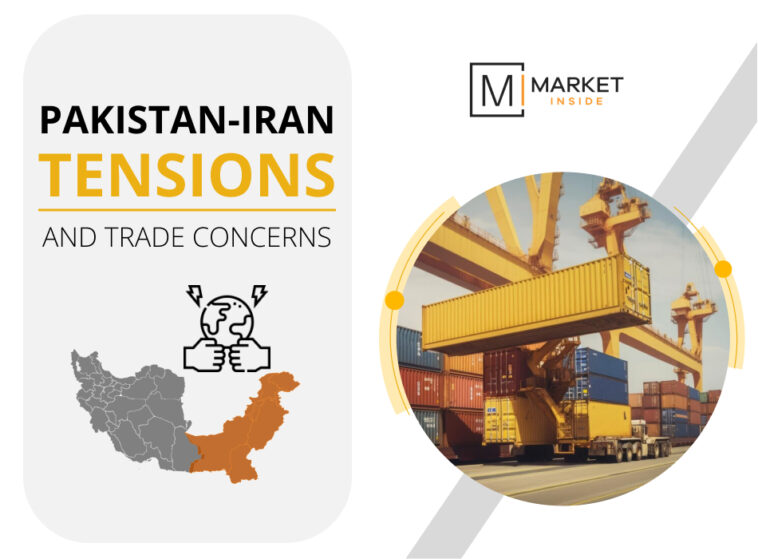Summary :
- Pakistan-Iran conflict raises questions over cross border trade.
- Standoff comes at a time of economic strife for Pakistan.
- Pakistan depends on imports from Iran.
- Pakistan’s imports from Iran were over USD 800 million in 2023.
- The conflict could impact their trade as the two countries signed a five-year trade plan in August 2023 and set the bilateral trade target at $5 billion.
As the world is already embroiled in the Russia-Ukraine war and the Israel-Palestine conflict, another war could bring serious implications for the world. This time war between Pakistan and Iran could impact global trade and Pakistan’s economy which is already struggling with problems. What would be the impact of conflict on Pakistan-Iran trade? What was the Pakistan-Iran trade relations in 2023? What Pakistan imports from Iran? Get answers of every trade related question that will help you take informed decisions.
What We Know So Far?
Pakistan conducted strikes inside Iran, targeting separatist Baloch militants after Iran has attacked the bases of another group within Pakistani territory. Economic ties with Iran, while not huge, are important for Islamabad as it struggles to supply its western most regions in Baluchistan with critical commodities.
What about Pakistan’s Overall Economy?
An escalation of geopolitical tensions between Pakistan and Iran has sent ripples through Pakistan’s bonds and stocks, and raised concerns on the country’s struggling economy. The country, where an election is scheduled for next month, is already facing a crippling financial crisis with its $350 billion economy beset by high inflation and yawning fiscal and current account deficits.
The International Monetary Fund (IMF) $3 billion assistance helped Pakistan to pull back from the brink of a sovereign debt default, but the short-term standby arrangement is set to expire this spring. The interruption of trade routes would have an immediate impact, including shortages in Pakistan and a notable decrease in the critical trade volume. The conflict could also significantly affect long-term collaborative projects like the Pakistan-Iran gas pipeline. The pipeline, already delayed, would transport natural gas from Iran to Pakistan and potentially India.
Pakistan-Iran Relations
Traditionally, Pakistan and Iran have cooperated on a lot of issues. They have border markets to promote cross-border trade. However, the trade ties between them have been weak due to American sanctions on Iran over its nuclear programme. Iran also supplies electricity to Pakistan and has built a transmission line in Pakistan. Reportedly, Iran can be a stakeholder in the China-Pakistan Economic Corridor (CPEC), a part of China’s ambitious Belt and Road Initiative (BRI). But last year, Pakistan temporarily shelved the multi-billion-dollar gas pipeline project to import cheap energy from Iran.
How Much Pakistan is Dependent on Imports from Iran?
In the last couple of years, Pakistan’s dependency on imports from Iran has increased and reached to new highs. According our market research report, Pakistan’s imports from Iran totalled USD 372 million in 2020 and crossed the USD 800 million mark in 2023. Here’s a data visualization of Pakistan’s imports from Iran reported from 2020 to 2023.

What Pakistan Imports from Iran?
Iran provides electricity to many areas in Pakistan, and there is sizeable unofficial trade in commodities including liquified petroleum gas and Iranian diesel. Pakistan passed a special order in June last year to allow barter trade with Iran, along with Afghanistan and Russia for certain commodities including petroleum and natural gas. Here is a list of Pakistan’s top import categories which the country trade with Iran with their values recorded in 2022.

| Product Category | Value USD Million | Value USD % |
| Mineral Fuels & Oils | 596 | 69 |
| Iron and Steel | 65 | 7 |
| Edible Vegetables and Certain Roots | 56 | 6 |
| Plastics and Articles | 43 | 5 |
| Raw Hides and Skins | 16 | 1 |
| Edible Fruits and Nuts | 16 | 1 |
| Coffee, Tea, Mate and Spices | 10 | 1 |
| Residues and Waste from Food Industries | 8 | 0.9 |
| Salt, Sulphur, Earths and Stones | 6 | 0.7 |
| Organic Chemicals | 5 | 0.6 |
Pakistan imported liquified gaseous hydrocarbons the most from Iran in 2023, followed by bitumen petroleum, electrical energy, waste and scrap of iron and steel, and coke and semi-coke of coal. Here’s a list of Pakistan’s top 10 imports with their values recorded in 2022 and 2023.

| Commodity | Value USD Million (2022) | Value USD Million (2023-Till Nov) |
| Liquified Gaseous Hydrocarbons | 531 | 403 |
| Bitumen Petroleum | 49 | 43 |
| Electrical Energy | 47 | 12 |
| Waste and Scrap of Iron & Steel | 30 | 29 |
| Coke and Semi-coke of Coal | 18 | 9 |
| Fresh or Chilled Tomatoes | 18 | 5 |
| Light Oils & Preparations | 17 | 102 |
| Fresh or Chilled Onions & Shallots | 16 | 3 |
| Raw Skins of Sheep or Lambs | 11 | 14 |
| Coriander Seeds | 9 | 9 |
Which are Top Import Partners of Pakistan?
Pakistan is majorly dependent on imports from China, followed by the United Aran Emirates. As China is the world’s biggest economy, Asian countries including Pakistan and India are heavily reliant on Chinese goods. Check the list of Pakistan’s top 10 import partners with data visualization.

| Country | Value USD Million (2022) | Value USD Million (2023) |
| China | 16,343 | 21,386 |
| United Arab Emirates | 7,943 | 10,106 |
| Saudi Arabia | 5,148 | 4,500 |
| Indonesia | 4,955 | 5,919 |
| Qatar | 4,139 | 3,000 |
| United States | 3,117 | 2,416 |
| Kuwait | 3,082 | 3,249 |
| Japan | 1,686 | 1,100 |
| Thailand | 1,452 | 880 |
| Brazil | 1,442 | 831 |
Impact of the Conflict
Pakistan-Iran conflict broadly adds to the crisis across the West Asian region, with Israel waging a war in Gaza and Yemen’s pro-Palestinian rebels attacking commercial vessels in the Red Sea. The situation could impact their trade as the two countries signed a five-year trade plan in August 2023 and set the bilateral trade target at $5 billion.
While Pakistan-Iran conflict flaring up into a war can’t be ruled out, all will depend on the postures of the United States and Russia which are respective backers of Pakistan and Iran.




